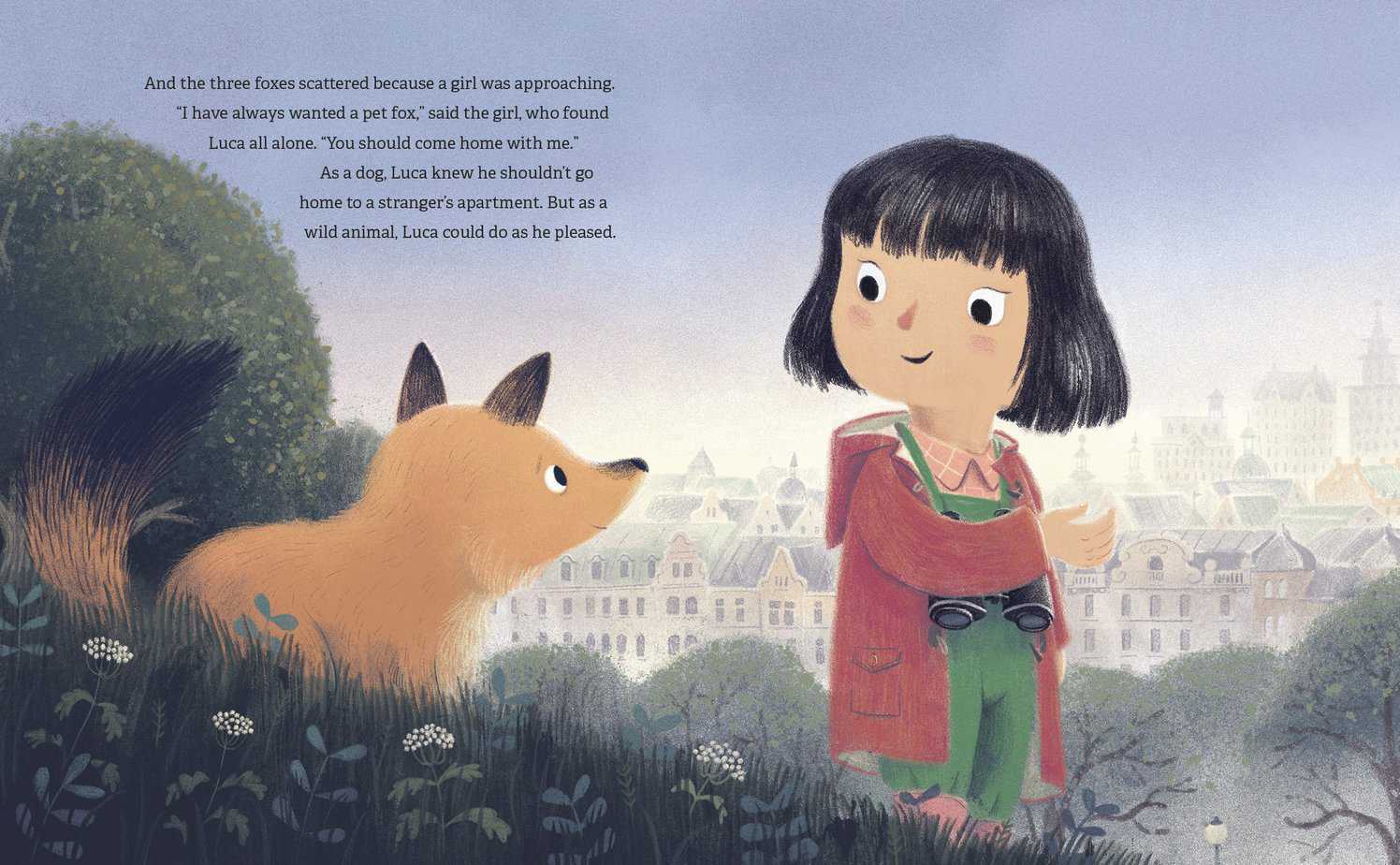I Am Not A Fox is a picture book written by Karina Wolf and illustrated by Chuck Groenink. If you’ve ever read “The Ugly Duckling” and thought, “hmm, that message has problems”, then this one might be for you.
SETTING OF I AM NOT A FOX
- PERIOD — contemporary
- DURATION — a few days, including at least one night
- LOCATION — I see others have recognised New York as the backdrop. I wasn’t so sure, perhaps because I’ve not been to New York. (Could be Toronto for all I know?) New York is well-known for being accepting of difference, which makes it the natural cityscape for a story like this.
- ARENA — This is a ‘city as fairytale arena’ story, with civilisation bordering the wild. The ‘fox’ is ostracised from civilisation and goes deep into the forest to find out who he is (really it’s the park).
- MANMADE SPACES — The city, the gated park
- NATURAL SETTINGS — the un-gated wilderness (which is still so close to the city we can see the buildings in the distance)
- WEATHER — Comfortable. The clothing suggests autumn?
- TECHNOLOGY CRUCIAL TO THIS PARTICULAR STORY — n/a
- LEVEL OF CONFLICT — An individual’s struggle to ‘find his tribe’
- THE EMOTIONAL LANDSCAPE — The canine characters in this story are obsessed with labels and boxes, whereas the humans are not. This is a complete inversion on reality, of course. From what I’ve observed of dogs (and all canines), they’re only interested in how each other smells. They don’t even seem to have a conception of differential size. Anyone who’s seen a Doberman cower at a chihuahua may agree!
STORY STRUCTURE OF I AM NOT A FOX
This picture book makes use of classic Odyssean mythic structure. A character goes in search of ‘home’ (read: family), meets various characters along the way, comes to some deep understanding of themselves and either returns home or finds a brand new one.
PARATEXT
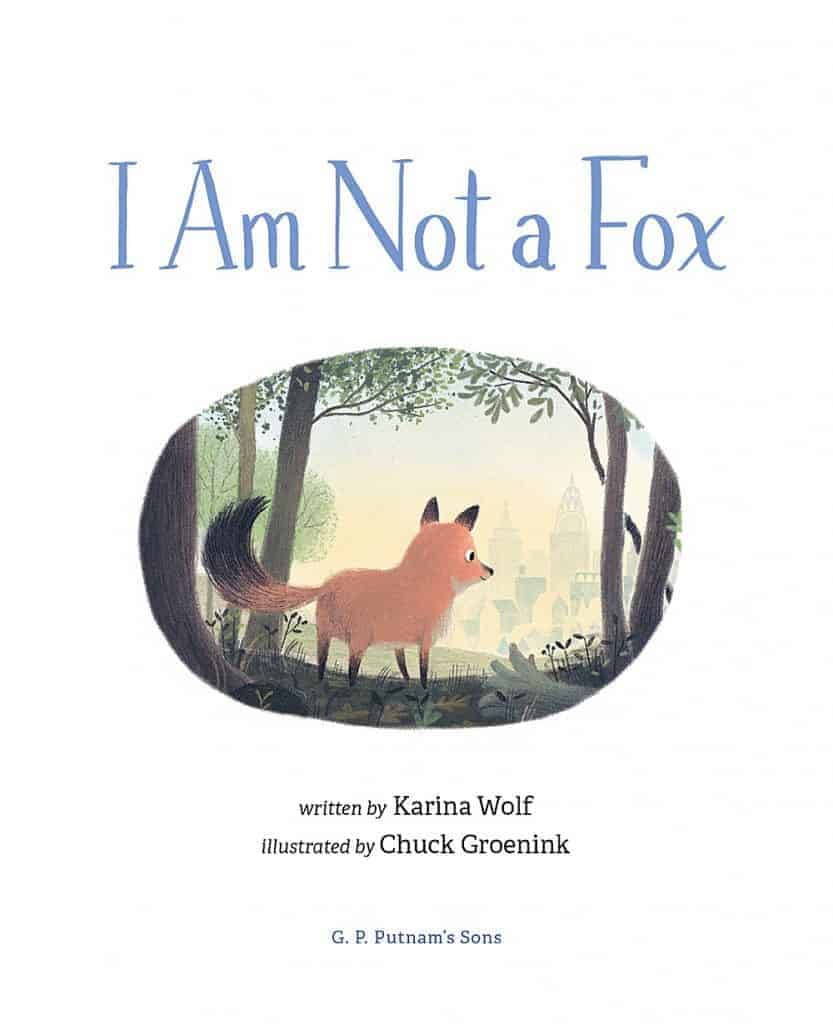
When Luca first arrives at the dog park, the other dogs turn him away. “You’re not a dog,” they say, “You’re a fox.” But . . . Luca likes to chase cats. He likes to yip at mailmen. And he likes sniff other dogs you-know-where. Still, Luca has to admit, he doesn’t look like the other dogs. So . . . he must be a fox, right? But when Luca finds a trio of foxes in the forest and asks to join them, they don’t think that Luca is a fox at all. After all, Luca acts just like a dog. Luca can’t seem to find anyone quite like him, but then he meets a caring little girl and finds something even better–a friend. In this heartwarming tale, Karina Wolf and Chuck Groenick remind us that you don’t need a label to find just where you belong.
MARKETING COPY
SHORTCOMING
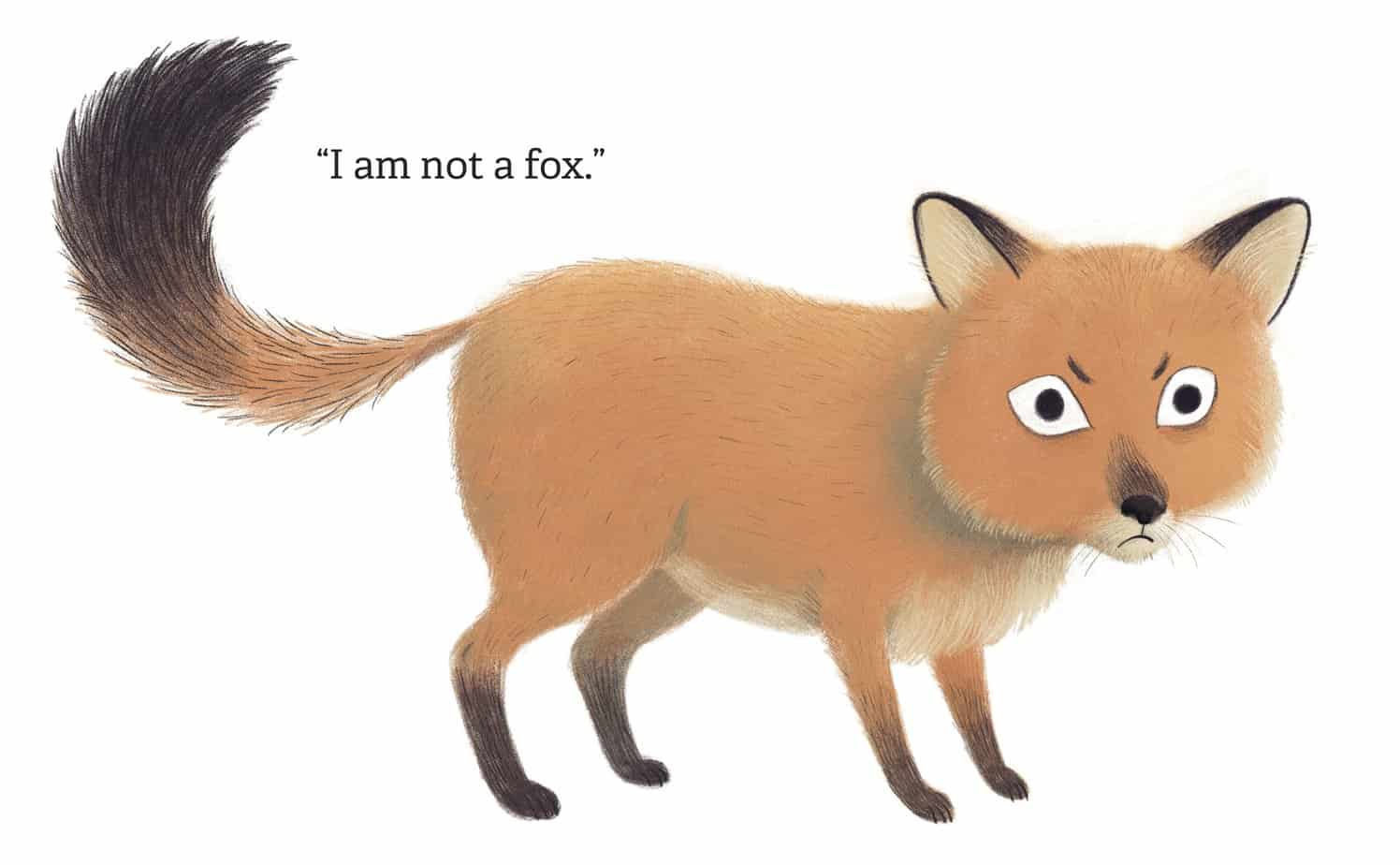
Luca has always assumed he is a dog, but isn’t so sure in his identity that he can simply brush off accusations of being a fox.
It’s important that this canine is a ‘wild animal’ who can do as he pleases. (Note how this is explicit in the text.) I’m thinking of Margaret Wise Brown, but mostly I’m thinking of a great number of children’s stories that were published before the age of microchipping, in which children went out, found an animal and brought it home to keep as a pet without really trying to find the pet’s owners. Modern storytellers can’t get away with that particular plot any longer. If a child finds a random new pet on the street it must be wild in the first place, or justified in some other way.
DESIRE
On the surface: Luca wants to find out his genetics.
Below the surface: Luca needs to find a tribe of likeminded (same-breed) canines before he can find acceptance. (He is later shown that this is a fruitless pursuit.)
OPPONENT
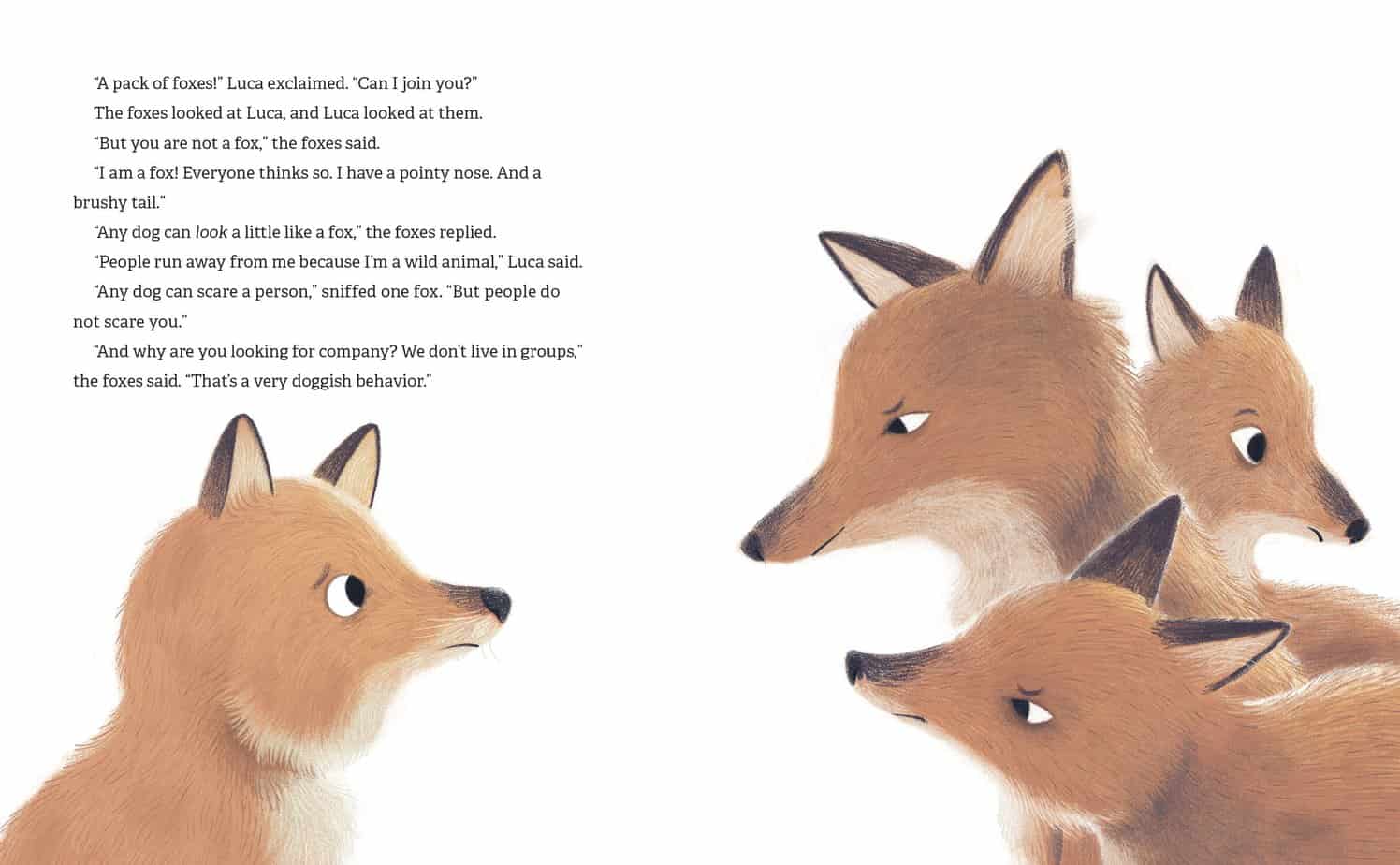
There are three similarly staged spreads in this picture book. The first show a close up of Luca on the verso, facing a gang of dogs on the recto. We see the same spread again when Luca meets the foxes, who turn out to be equally oppositional and unwelcoming. (Finally we’ll see Luca on the recto, and know that he’s ‘taken his power’, because this pattern has already been set up.)
PLAN
Luca does his research. He observes other dogs at the park and observes he doesn’t look like any of them.
As reader, I observe that none of the other dogs look like each other, either. At first I thought this was a problem with the plot. But perhaps that’s exactly what we’re meant to think, leaving an ironic gap between me and Luca. Now I need to wait for Luca to draw the conclusion that I already had, helped by the spread with all the different dogs: EVERYBODY is different. Tribes based on similarities in appearance are superficial, arbitrary and useless.
When my kid read the book (which she loved) she pointed to a dog who does in fact look a litle like Luca (on the far left). I do think this is a bit of a problem for the story progression.
Luca ends up at the art gallery where he sees a painting of a skulk of foxes and comes to the realisation that he must be a fox after all. This is not the Anagnorisis part of the story, because it is a false Anagnorisis.
THE BIG STRUGGLE
Luca’s night in the woods. He looks cute all curled up in the bush.
ANAGNORISIS
After emerging from the forest, Luca meets a girl. Humans have been absent from the story until now.
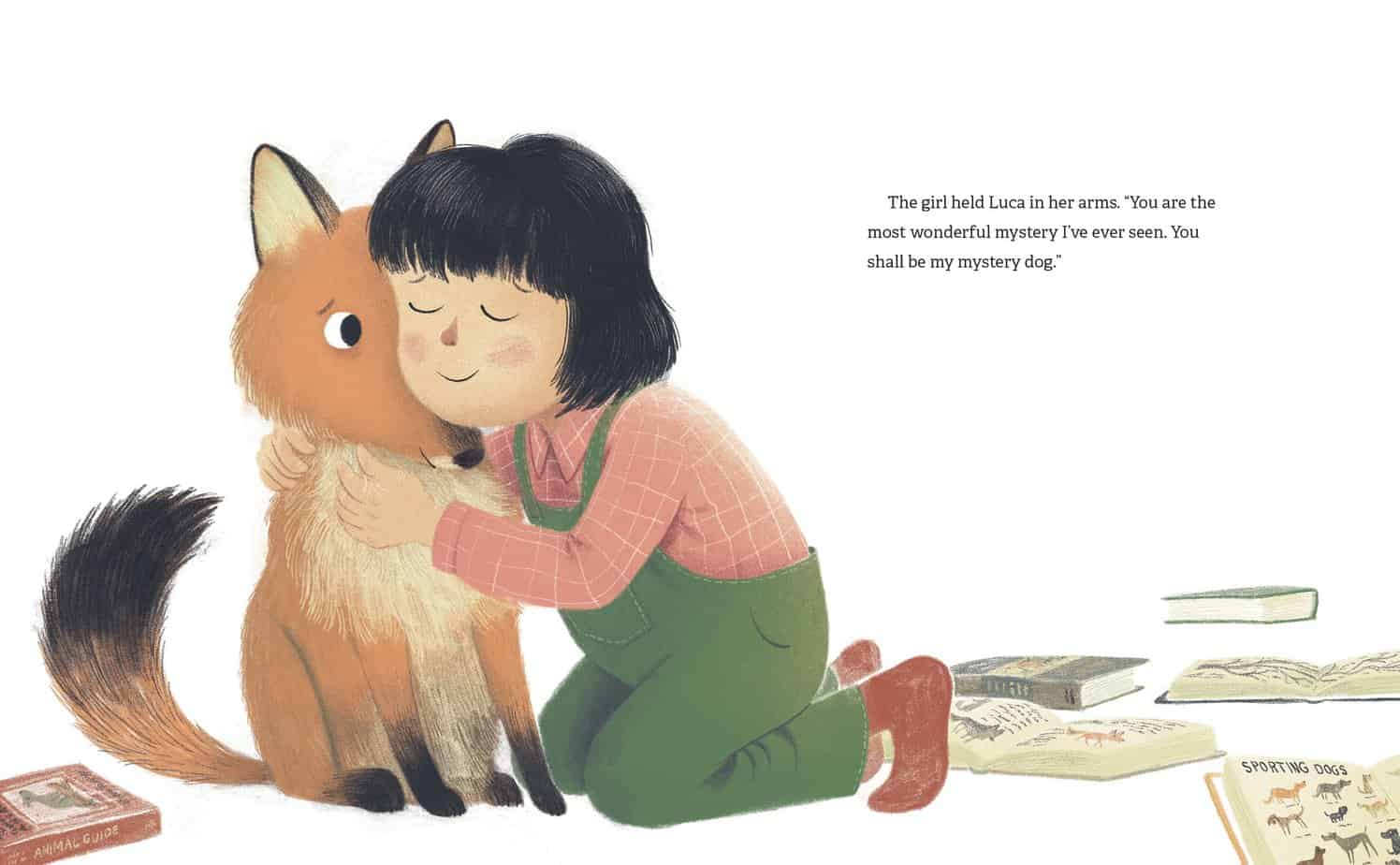
Once the actual foxes reject Luca for not being sufficiently foxy, he returns to the city having realised he fits in nowhere. The girl points out that all the humans are dressed in different ways.
But it’s not until he faces the Doberman bully and his pack at the park that he shows readers his true understanding: He doesn’t need to find any other canine who looks exactly like him. He has a friend, and his human friend is nothing like him. And that’s just fine.
NEW SITUATION
The fox/dog can live a decent life as a dog because he has a human companion.
I guess it was inevitable that humans are a little over-glorified in this story. (We like to think domesticated dogs can’t be happy without us, but is this really true?) However, my expectations were nicely subverted…
EXTRAPOLATED ENDING
There exists a great number of children’s stories about a forlorn animal who cannot find its own family, starting, perhaps, with Hans Christian Andersen’s “The Ugly Duckling” as the O.G. of them all. The ideology of those Ugly Duckling books goes like this: You won’t find happiness until you find your tribe. Subtext reading: Your tribe are just like you.
Cold comfort, then, for child readers who will never find people just like them, perhaps because of a very rare genetic difference, a facial difference a la Wonder. I Am Not A Fox breaks this mold, because “Fox” never finds a creature just like her, and that’s a-okay.
This is also what makes I Am Not A Fox a contemporary take on the Ugly Duckling plot. Humans will always need stories about belonging. Stories about this form of individualism feel much newer.
Individualism has its down side. But how much happier might Hans Christian Andersen have been, had he lived in a culture where he was fully accepted for being exactly himself?
RESONANCE
Now for a bit of a compare and contrast, with one of my favourite short stories, “Louisa, Please Come Home.” We might use this picture book as an introduction to teaching middle schoolers the short story “Louisa, Please Come Home” by Shirley Jackson.
Can you see what made me think of Shirley Jackson’s resonant story? A young woman leaves home without telling her family where she’s off to. Her parents never stop looking for her, and every year, they plead on the radio for her return. Finally, Louisa has a change of heart and decides to return. But once she gets there, her parents don’t recognise her as their daughter Louisa, and assume she’s an imposter. Reckless Louisa has shot herself in the foot and has now lost her natal family forever. Like the fox in this picture book, Louisa must now learn to live forever as an estranged outcast, always the outsider, and probably feeling like a chimera of her former self, comprising parts of the Before Louisa (remembered by her family) and parts of the Present Louisa (known only to herself).
This picture book is a far more cosy story, but both are about characters who don’t fit in anywhere, and who are rejected for being themselves, all because of how they look on the surface.
I don’t know about you, but the final sentence left me humming “My Name Is Luka” for some hours afterwards.
